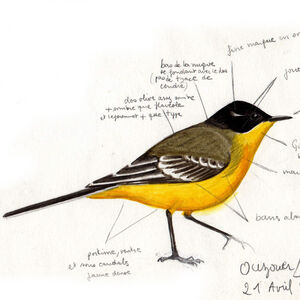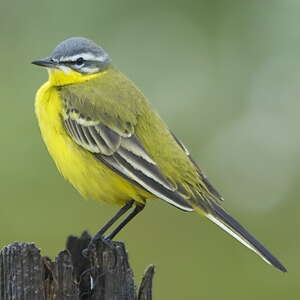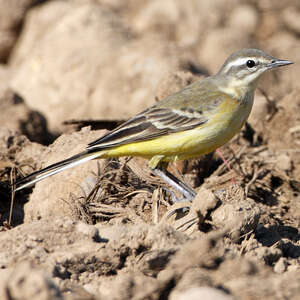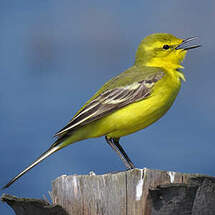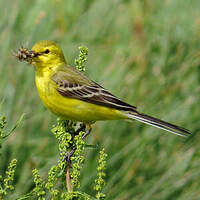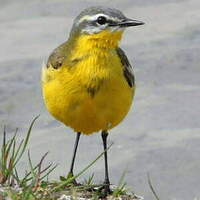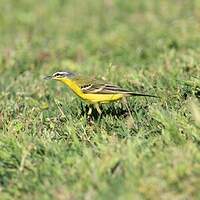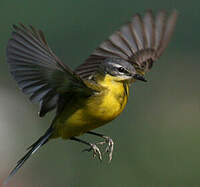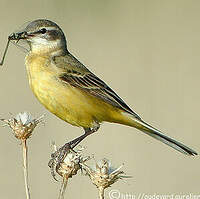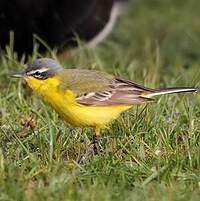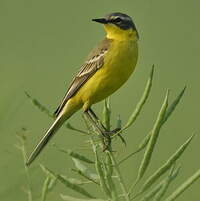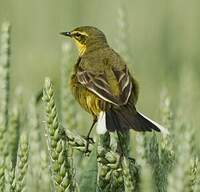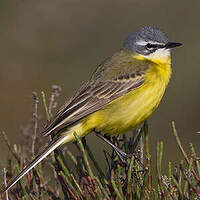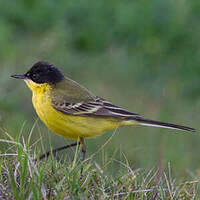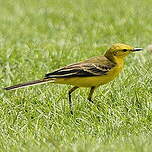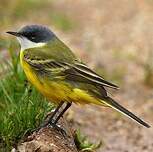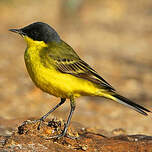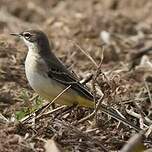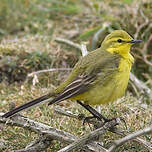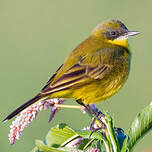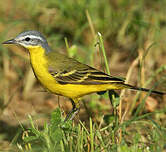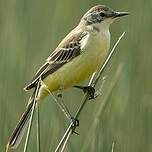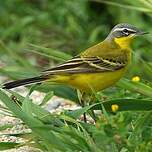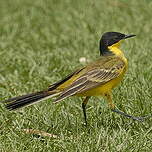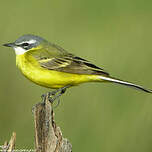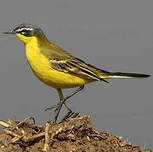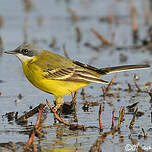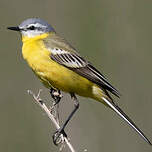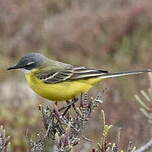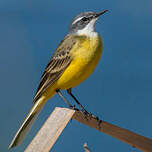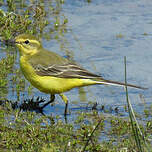Western Yellow Wagtail
Motacilla flava - Bergeronnette printanière
Identification
The Western Yellow Wagtail is a very polymorphic species, with 10 subspecies within its vast range of the Old World. Morphologically, it is a typical wagtail with long legs, long tertials and a fairly long tail bordered with white and agitated in a vertical plane. The plumage of the male adult is constant regardless of the subspecies, with green upperparts and yellow underparts. The head is what presents variations in colour according to the subspecies, distinct in males breeding, much less in females. In this species, the sexes differ significantly. We will focus on the flava subspecies which we are most used to. On the other hand, we will only evoke the other subspecies without detailing them, it would be too tedious. The images show the different male phenotypes. The male adult breeding flava has the upper and sides of the head ash gray, the chin and throat yellow-buttercup. A distinct white eyebrow runs from beak to nape. A blackish loral stripe joins the bill to the dark eye outlined by a white arch. Finally, the gray ear covers include a small white band. The alula and tertial feathers are blackish and widely bordered with clear. The beak and legs are black. Sexual dimorphism is quite strong. The adult female is like a very dull male, with washed out colours. The gray-brown mantle is tinged with green. The lower parts are less bright yellow and less regular. The head presents the same pattern as the male's, but is gray-brown on the upper and sides and whitish on the throat. The juvenile is significantly different and can be questioned. Its plumage is completely devoid of carotenoid pigment and can therefore not be either yellow or green like the adult.
Subspecific information 10 subspecies
- Motacilla flava flava (n and c Europe to the Ural Mts.)
- Motacilla flava flavissima (Britain and coastal Europe)
- Motacilla flava lutea (sw Russia to nw and nc Kazakhstan)
- Motacilla flava beema (sw Siberia and ne Kazakhstan to w Himalayas)
- Motacilla flava iberiae (Iberian Pen., sw France and nw Africa)
- Motacilla flava cinereocapilla (Italy, Sicily, Corsica, Sardinia and Slovenia)
- Motacilla flava pygmaea (Egypt)
- Motacilla flava leucocephala (nw Mongolia, nw China and sc Siberia)
- Motacilla flava feldegg (the Balkans and Turkey to Iran and Afghanistan)
- Motacilla flava thunbergi (n Europe to nw Siberia)
Foreign names
- Bergeronnette printanière,
- Lavandera boyera,
- alvéola-amarela-comum,
- Schafstelze,
- sárga billegető,
- Gele Kwikstaart,
- Cutrettola,
- gulärla,
- Gulerle,
- trasochvost žltý,
- konipas luční,
- Gul Vipstjert,
- keltavästäräkki,
- Geelkwikkie,
- cuereta groga,
- Gulerla,
- pliszka żółta,
- dzeltenā cielava,
- rumena pastirica,
- Жёлтая трясогузка,
- Kicuit kerbau,
- ニシツメナガセキレイ,
- 西黄鹡鸰,
- 西方黃鶺鴒,
Voice song and cries
The usual call is a single or double fsip. It is uttered both on the ground and in flight. One can also hear tsri calls that are slightly rolled. Worried, the bird gives out more insistent pisiip calls. The song is simplistic and consists of the monotone repetition of notes that recall one of the calls without any particular connective, tsritsritsri tsritsritsri tsritsritsritsri tsri tsritsritsri pilip tsritsri.... The singer perches conspicuously on a tall herbaceous plant or on a low shrub. There are variations in intonation depending on the subspecies. The feldegg subspecies for example is known for its harsher calls, tsrrié.
Habitat
The Western Yellow Wagtail is a bird of open to semi-open, preferably wet, habitats with easy access to the ground.
Behaviour character trait
As with all Motacillidae, the Western Yellow Wagtail's most activity takes place on the ground where its large legs give it an advantage in exploring the terrain with ease.
It is gregarious for most of the year, and on migration it moves in flocks and enjoys the company of its congeners in wintering zones. Although monogamous and territorial for breeding, it can be seen in groups of adults nesting and hunting together in more favorable areas. In the spring, on the breeding ground the male is very showy. His bright yellow-buttercup plumage that he proudly displays is an effective argument in defending his territory, accompanied by his not particularly impressive song. On the other hand, the female's plumage is much more discreet as it is her job to protect the nest.Flight
Dietfeeding habits
The Western Yellow Wagtail is essentially insectivorous. It looks for its food on the ground by actively walking in open areas or even in shallow water.
Its prey can thus be both terrestrial and aquatic, and are correspondingly very varied. Insects predominate, but other invertebrates such as small freshwater crustaceans can occasionally be important. It appreciates places where insects abound, for example the edge of the waters when a number of aquatic larvae imagos emerge. This is also what brings it to visit pastures where the dung and other excretions of domestic herbivores attract sucking or coprophagic insects, diptera and coleoptera especially. In general, diptera are particularly well represented in the diet all year round. Very occasionally, it can consume small seeds or small berries in accordance with the seasons and sites. The juveniles are exclusively fed on invertebrates, insects and their larvae mainly, but also small crustaceans.Reproduction nesting
The breeding season extends from April to August, with the laying date varying according to latitude.
The species is monogamous and territorial. The nest is built mainly by the female and is a cup made of grass and placed on the ground or very close to the ground under a vegetal shelter. It is lined with hairs and other fine elements. The laying consists of 4 to 6 dark eggs, grey-beige to olive in color, faintly speckled with rusty brown. Incubation is carried out by both sexes, but mainly by the female, for 11 to 14 days. Then the chicks are fed at the nest by their parents for an equivalent period of time. After flying, the young will still depend on the adults for a certain period of time, but the female may be quickly occupied by a second nesting if necessary. The families then meet again in favorable spaces. The Western Yellow Wagtail is one of the species whose clutches can be parasitized by the Eurasian Cuckoo.Geographic range
The Western Yellow Wagtail occupies the Eurasian continent from the Atlantic to the Lena Valley in Siberia, passing through Kazakhstan and the northwest region of Mongolia. Southward, it occupies the west of Morocco, the Nile Valley in Egypt, Asia Minor, occasionally the Middle East, northern parts of Persia, Central Asia, and northwest corner of China. Beyond that, is its sister species, the Beringian Wagtail, which only recently was separated from it. It is a migratory species, except for ssp. pygmea in Egypt and the Moroccan fraction of ssp. iberiae that are sedentary. Its wintering grounds are in Sub-Saharan Africa and the Indian subcontinent, and occasionally the Arabian Peninsula. The ssp. type "flava" occupies temperate continental Europe up to the Ural Mountains, the one that mostly nests in France. The ssp. "flavissima" is found in the British Isles and across the European coasts. The ssp. "thunbergi" is found in Scandinavia and western Siberia. The ssp. "iberiae", as its name implies, is found in the Iberian Peninsula, but also south-western France and Morocco. The ssp. "cinereocapilla" is found in the Italian boot, but also Sardinia and Sicily, and Slovenia. The ssp. "pygmaea" occupies the Nile Valley in Egypt where it is sedentary. The ssp. "feldegg" is found southwards from Balkans to Afghanistan, through Turkey, Iran, and Iraq. In western Russia, the ssp. "beema" and "lutea" are found around the Volga River; the former in the north (High Volga and western Siberia), the latter in the south (Lower Volga, Kazan and Perm regions, and north of Kazakhstan). Lastly, the ssp "leucocephala" occupies the northwest of Mongolia and China, and adjacent Russian regions.
Threats - protection
IUCN conservation status
concern
in the Wild
threatened
evaluated
Western Yellow Wagtail is one of the common species that are not classified as threatened by BirdLife International. Its range is wide and has been able to adapt to human-influenced environments, mainly agricultural ones, and take advantage of them. But it is still sensitive to human action. The decline observed locally is related to the intensification or change in agricultural practices, particularly the drainage of wetlands and plowing of meadows for cereals. In addition, the use of pesticides in agriculture can only have a negative effect. As the species is migratory, it can be exposed to the consequences of chronic droughts in the wintering areas, particularly for European birds, and the degradation of the conditions for wintering in the Sahel.
Sources of information
- IOC World Bird List (v14.1), Gill, F and D Donsker (Eds). 2024-04-18.
- Les passereaux d'Europe, tome 1, P. Géroudet, M. Cuisin
- Pipits and Wagtails of Europe, Asia and North America, Alström Per and Mild Krister
- Avibase, Lepage Denis
- Birds of the World, The Cornell Lab of Ornithology
- xeno-canto, Sharing bird sounds from around the world,
Other sources of interest
 Specification sheet created on
20/07/2023 by Jean François
Specification sheet created on
20/07/2023 by Jean FrançoisTranslation by AI Oiseaux.net
published: 13-03-2021 - Updated: 20-05-2021
© 1996-2024 Oiseaux.net
- Accipitriformes
- Aegotheliformes
- Anseriformes
- Apodiformes
- Apterygiformes
- Bucerotiformes
- Caprimulgiformes
- Cariamiformes
- Casuariiformes
- Charadriiformes
- Ciconiiformes
- Coliiformes
- Columbiformes
- Coraciiformes
- Cuculiformes
- Eurypygiformes
- Falconiformes
- Galliformes
- Gaviiformes
- Gruiformes
- Leptosomiformes
- Mesitornithiformes
- Musophagiformes
- Nyctibiiformes
- Opisthocomiformes
- Otidiformes
- Passeriformes
- Pelecaniformes
- Phaethontiformes
- Phoenicopteriformes
- Piciformes
- Podargiformes
- Podicipediformes
- Procellariiformes
- Psittaciformes
- Pterocliformes
- Rheiformes
- Sphenisciformes
- Steatornithiformes
- Strigiformes
- Struthioniformes
- Suliformes
- Tinamiformes
- Trogoniformes

